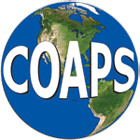




This page explains how the TAO Buoy data were adjusted for use in the FSU Pacific Pseudostress Analyses beginning with January 1996 for the Research Quality Product, and January 1998 for the Quick Look product.
Quick Facts about the WOCE SAC Products
This is an important note to all who are using the FSU tropical Pacific monthly pseudostress products.
We have altered the processing of data for these analyses and this change may affect your research/operational efforts. We apologize for the late notice regarding these changes (they have been in effect for ~10 months).
Our revised data processing recognizes daily TAO mean wind observations as originating from 4-m above the ocean surface and adjusts them to 20-m height (nominal ref height) before they are used in our analysis. From this point we use the same grid and analysis techniques - only the treatment of TAO wind data are different.
The end result is stronger winds in the 10S to 10N band, and especially in the 120-135W and 170W-180 regions. This amplification of the winds due to the height adjustment is not uniform in space or time (due to atmospheric stratification effects) and thus makes interpretation more interesting.
These changes went into effect for the 1998 quicklook analyses. We are nearing completion of a manuscript providing a detailed examination of the impacts of the TAO adjustments on our products based on comparisons of our original analyses and a revised set of FSU pseudostress products for the tropical Pacific for the period of January 1996 through Dec 1997.
We are interested in receiving any feedback on these changes and impacts on prediction/analysis efforts.
A PDF form of the poster presented recently at the Climate Diagnostics Workshop (Nov 1998) describes a preliminary analysis of the revised wind fields.
The revised data files (same format as our regular FSU products) are found in our FTP site (coaps.fsu.edu) as a compressed tar file /pub/jns/fsu9697.tar.gz.
| 1996 | Quicklook | Research-Quality | Research-Quality(ADJ)* |
| 1997 | Quicklook | Research-Quality(ADJ)* | |
| 1998 | Quicklook(ADJ)* | Research-Quality(ADJ)* - To be released 1999 | |
| * ADJ = Adjusted | |||
The TAO array consists of approximately 70 ATLAS and current meter moorings in the Tropical Pacific Ocean, telemetering oceanographic and meteorological data in real-time via the Argos satellite system. We removed the TAO data transmitted via GTS and replaced it with daily averages obtained from PMEL. All buoys measure the following meteorological variables:
The TAO data are then adjusted using the Bourassa-Vincent-Wood method (Bourassa, et al. 1998) and configured as follows:
BVW model is set to a local wind-wave equilibrium condition, Fairall's approximation (Fairall, et al., 1996a) of sea surface humidity (98%), the convective parameterization is set to 1.25, with a wind sensor height of 4m measured and adjusted to 20m. For unstable conditions, the Benoit (1977) parameterization was used, and for stable conditions, Beljaars and Holtslag (1991) parameterization was used, a Monin-Obukhov length scale is calculated as described in Liu, et al. (1979), with momentum roughness length model from Bourassa, et al. (1998), and heat and moisture roughness length parameterization from Brutsaert (1982) and Smith (1988, 1992).
Further information on WOCE-MET Web pages can be obtained by mailing: wocemet@coaps.fsu.edu.
Last Modified: Sun, 10 Jan 1999